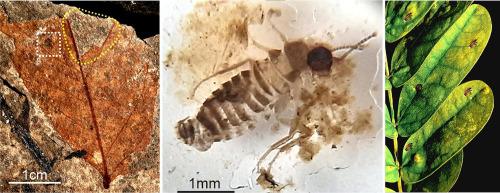Journal of Asia-Pacific Entomology ( IF 1.5 ) Pub Date : 2020-07-08 , DOI: 10.1016/j.aspen.2020.06.004 Manoshi Hazra , Taposhi Hazra , Robert A. Spicer , Subhankar Kumar Sarkar , Teresa E.V. Spicer , Subir Bera , Mahasin Ali Khan

|
In situ preservation of fossil insect damage in plant fossils is an excellent tool to study the coevolution of flora and fauna through geological time, but finding both damage and the insect causing that damage in the same specimen is a very rare phenomenon. Galling is a common form of angiosperm leaf damage, which can be regarded as a kind of extended phenotype of the causal insects, essentially the gall midges, but galls usually lack remains of the insects themselves. Here we report the in situ occurrence of a gall midge (Insecta, Diptera, Cecidomyiidae) as well as its pupal exuviae on the abaxial cuticular surface of fossilized leaf cuticle fragments of Fabaceae leaves (cf. Albizia) that also bear galls, recovered from the latest Neogene (Rajdanda Formation, Pliocene) sediments of the Chotonagpur Plateau, Jharkhand, northeastern India. This Pliocene gall midge features well-preserved legs, segmented antenna with distinct and enlarged scape, elongate curved setae, and longer than broad terminal plate of the ovipositor lamellae. The in situ presence of a gall midge on a host fabaceous leaf cuticle indicates the existence of a host-ectoparasite relationship in the ancient warm and humid tropical monsoon-influenced forests of eastern India during the Pliocene. This is the first authentic fossil record of an in situ phytophagous insect of Cecidomyiidae from India, as well as southeast Asia. Although the identification of the recovered phytophagous insect associated with the fossil leaf cuticle is only possible to family level, this find reveals that such plant-insect relationships existed in the Pliocene of eastern India.
中文翻译:

印度东部上新世沉积物的化石被子植物叶子表皮碎片上原位发生mid虫(昆虫纲,双翅目,天蛾科)
在化石中原位保存化石昆虫的损害是研究整个地质时期动植物群协同进化的极好工具,但是在同一标本中同时发现损害和引起该损害的昆虫是非常罕见的现象。擦伤是被子植物叶片损坏的一种常见形式,可以认为是引起原因的昆虫的一种扩展表型,本质上是虫mid,但是虫s通常缺乏昆虫本身的残留。在这里,我们报告了科叶片化石的叶片表皮碎片的背面表皮表面上的mid虫(昆虫纲,双翅目,天蛾科)及其ex虫原位发生的情况(参见Albizia)也有胆虫,这些胆虫是从印度东北部贾坎德邦Chotonagpur高原的最新新近纪(上新世拉杰丹达组)沉积物中回收的。上新世的mid蚊特征是腿部保存完好,具有明显且扩大的花scape的分段天线,细长的弯曲刚毛,长于产卵器薄片的宽末端板。在原位上的主机豆苗叶角质层一个瘿蚊的存在表明在古代温暖主机,外寄生虫关系的存在和上新世在潮湿印度东部的热带季风影响的森林。这是原位的第一个真实化石记录印度和东南亚的Ce虫科的植物性食虫昆虫。尽管鉴定出与化石叶片角质层相关的植食性昆虫仅在家庭层面是可能的,但这一发现表明,这种植物与昆虫的关系存在于印度东部的上新世。


























 京公网安备 11010802027423号
京公网安备 11010802027423号